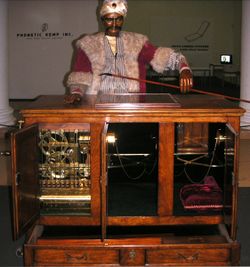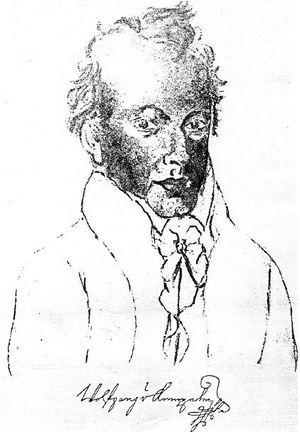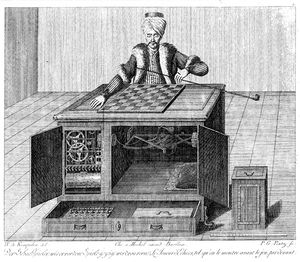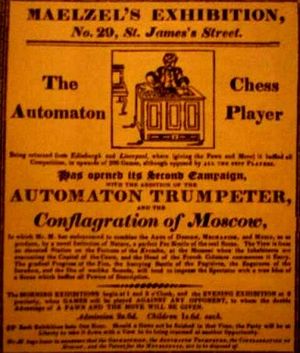التركي الآلي
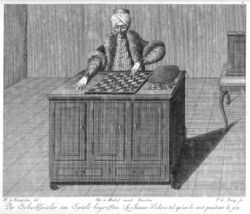
التركي The Turk، أو التركي الميكانيكي أو الأوتوماتون لاعب الشطرنج (ألمانية: Schachtürke، "التركي لاعب الشطرنج"' مجرية: A Török) كان ماكينة خادعة تلعب الشطرنج، بـُنيت في القرن 18. من 1770 حتى أن دمرها حريق في 1854، عرضها ملاكها العديدون كأوتوماتون، بالرغم من أنها شـُرحت في مطلع عقد 1820 على أنها كانت خدعة hoax معقدة.[1] وبناها وأظهرها على الملأ في 1770 ڤولفگانگ فون كمپلن (1734–1804) ليبهر الامبراطورة ماريا تريسا، الآلية بدت قادرة على لعب مباراة شطرنج قوية ضد خصومها البشريين، كما كانت قادرة على أداء جولة حصان الشطرنج، وهي أحجية تتطلب من اللاعب أن يحرك الحصان ليحتل كل مربع في رقعة الشطرنج مرة واحدة فقط.
وقد كان التركي الآلي في الواقع خداع ميكانيكي أتاح للاعب شطرنج آدمي متمكن من الاختباء داخلها ليـُشغـِّل الماكينة. وبمشغل ماهر، فاز التركي الآلي معظم المباريات التي لعبها أثناء عروضه في أرجاء اوروبا والأمريكتين على طوال 84 عاماً، لاعب وهزم العديد من المتحدين ومنهم رجال دولة أعلام مثل ناپليون بوناپرت وبنجامين فرانكلين. وبالرغم من أن كثيرين شكوا في وجود مشغل آدمي داخله، إلا أن الخدعة كـُشِف عنها لأول مرة فقط في عقد 1820 من قِبل اللندني روبرت وليس.[2]
الإنشاء
اُلهِم كمپلن بفكرة التركي الآلي بعد زيارته بلاط ماريا تريسا من النمسا في قصر شونبرون، حيث كان فرانسوا پلتييه يؤدي عروضاً خداعية. وقد أدى حوار بعد ذلك العرض إلى وعد من كمبلن لأن يعود إلى القصر باختراع سيفوق تلك الخدع.[3]
The result of the challenge was the Automaton Chess-player,[4][5] known in modern times as The Turk. The machine consisted of a life-sized model of a human head and torso, with a black beard and grey eyes,[6] and dressed in Turkish robes and a turban—"the traditional costume," according to journalist and author Tom Standage, "of an oriental sorcerer." Its left arm held a long Turkish smoking pipe while at rest, while its right lay on the top of a large cabinet[7] that measured about three-and-a-half feet (110 cm[8]) long, two feet (60 cm) wide, and two-and-a-half feet (75 cm) high. Placed on the top of the cabinet was a chessboard, which measured eighteen inches square. The front of the cabinet consisted of three doors, an opening, and a drawer, which could be opened to reveal a red and white ivory chess set.[9]
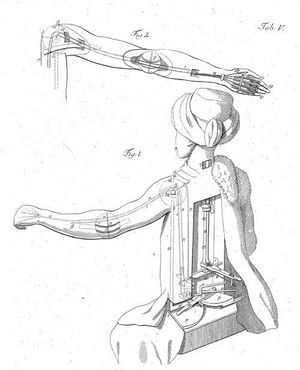
أحشاء الماكينة كانت بالغة التعقيد ومصممة لتضلل من يراقبونها.[3] وحين تُفتح من اليسار، فإن الأبواب الأمامية للخزانة تكشف عن عدد من التروس والتعشيقات مماثلة آلية الساعة. The section was designed so that if the back doors of the cabinet were open at the same time one could see through the machine. The other side of the cabinet did not house machinery; instead it contained a red cushion and some removable parts, as well as brass structures. This area was also designed to provide a clear line of vision through the machine. Underneath the robes of the Turkish model, two other doors were hidden. These also exposed clockwork machinery and provided a similarly unobstructed view through the machine. The design allowed the presenter of the machine to open every available door to the public, to maintain the illusion.[11]
As a further means of misdirection, the Turk came with a small wooden coffin-like box that the presenter would place on the top of the cabinet.[3] While Johann Nepomuk Mälzel, a later owner of the machine, did not use the box,[12] Kempelen often peered into the box during play, suggesting that the box controlled some aspect of the machine.[3] The box was believed by some to have supernatural power, with Karl Gottlieb von Windisch writing in his 1784 book Inanimate Reason that "[o]ne old lady, in particular, who had not forgotten the tales she had been told in her youth … went and hid herself in a window seat, as distant as she could from the evil spirit, which she firmly believed possessed the machine."[5]
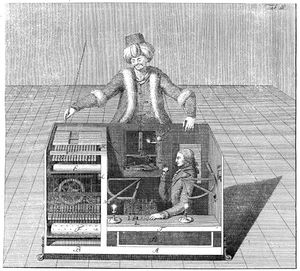
The interior also contained a pegboard chess board connected to a pantograph-style series of levers that controlled the model's left arm. The metal pointer on the pantograph moved over the interior chessboard, and would simultaneously move the arm of the Turk over the chessboard on the cabinet. The range of motion allowed the director to move the Turk's arm up and down, and turning the lever would open and close the Turk's hand, allowing it to grasp the pieces on the board. All of this was made visible to the director by using a simple candle, which had a ventilation system through the model.[13] Other parts of the machinery allowed for a clockwork-type sound to be played when the Turk made a move, further adding to the machinery illusion, and for the Turk to make various facial expressions.[14] A voice box was added following the Turk's acquisition by Mälzel, allowing the machine to say "Échec!" (French for "check") during matches.[4]
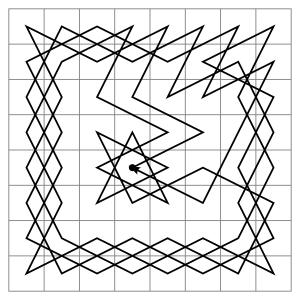
مالتسل والآلة
بعد وفاة كمپلن، ظل التركي بدون عروض لبعض الوقت حتى 1808 عندما قرر ابن كمپلن بيعه إلى يوهان نپوموك مالتسل، الموسيقي الباڤاري المولع بالآلات والأجهزة. وكان مالتسل، الذى شملت نجاحاته تسجيل براءات الاختراع شكل من أشكال المترونوم كان قد حاول شراء التركي مرة من قبل، قبل وفاة كمپلن. وقد فشلت المحاولة الأولى، وذلك بسبب السعر المرتفع الذي طلبه كمپلن، فقد طلب 20.000 فرنك، ولكن نجل كمپلن باع الجهاز بنصف هذا المبلغ إلى مالتسل.[16]
وفور الحصول على التركي، كان على مالتسل أن يتعلم أسراره واجراء بعض التصليحات للحصول عليه مرة أخرى يعمل كسابق عهده. وكان هدفه المعلن هو جعل التركي تحديا كبيراً. وبينما استغرق الانتهاء من هذا الهدف عشر سنوات، فقد استمر التركي في الظهور العديد من المرات، وكان على الأخص مع نابليون بونابرت.[17]
وفي عام 1809، وصل نابليون الأول في فرنسا في قصر شونبرون للتنافس مع التركي الآلي.
ووفقا لتقرير شاهد عيان، اتخذ مالتسل المسؤولية عن بناء الجهاز أثناء التحضير للعبة، وكان التركي (يوهان المعمدان Allgaier) قد حيا بونابرت قبل بداية المباراة.
وقد نشرت تفاصيل المباراة على مر السنين في العديد من المصادر، وكثير منهم متناقض.[18] حسب روايةبرادلي إيوارت، إنه من المعتقد أن الترك , وبونابرت جلسا إلى مائدتي شطرنج منفصلتين. وكانت مائدة بونابرت محاطة بحبل مشدود, ولم يكن مسموحاً له بالعبور إلى منطقة التركي وكان مالتسل يعبر ذهاباً وعودة، كي يسمح برؤية واضحة للمتفرجين والشهود. وفى حركة مفاجئة، أخذ بونابرت باللعبة الأولى المقررة للتركي، كالمعتاد؛ ولكن مالتسل سمح للعب بالإستمرار. وبعد وقت وجيز لعب بونابرت لعبة غير قانونية. وحينها أدرك التركي تلك الخطوة، أعاد القطعة إلى مكانها الأصلي واستمر في اللعب. وحاول بونابرت هذه الخطوة غير القانونية للمرة الثانية، وإستجاب التركي بإزالة جزء من اللوحة تماما وأخذ دوره. حاول بونابرت النقلة الخاطئة مرة ثالثة ،ولكن الترك أجاب بان لوح بذراعه مطيحا بكل القطع من على طاولة اللعب . وكان الأمر لبونابرت مسليا، وبعد ذلك لعب لعبة حقيقية مع الآلة ، واستكمل خطوات حاسمة على مدى 19 خطوة قبل أن يضع ملكه جلالة الملك خطوة الإستسلام.[19] وقيلت روايات عديدة من القصة التي تشمل استياء بونابرت من خسارته أمام الآلة، ولعب مع التركي مرة أخرى في وقت لاحق، ولعب مباراة واحدة مع المغناطيس على الطاولة. ولعب مباراة مع شال حول رأس وجسم الترك وذلك في محاولة لحجب رؤيته.[20]
بعد إعادة الشراء .
جلب Mälzel الترك عائدا إلى باريس حيث أدى عددا من العروض لدى كثير من المشاهير من لاعبى الشطرنج في Café de la Régence. وبقى Mälzel في باريس مع الآلة حتى عام 1818 , حيث إنتقل إلى لندن وأدى العديد من العروض ,وكانت بين الترك وعديد من آلات الشطرنج الأخرى . وفى لندن,Mälzel Mälzel فإنه هو وآلته إستقطبا العديد من وسائل الإعلام والصحف,و إستمر في تحسين الآلة ,[22]ونهاية المطاف قام بتثبيت مربع في الجهاز يصدر صوتا حتى يمكن القول "échec!" عندما وضع لاعب في وضع (كش ملك).[23]
الأعوام الأخيرة وما بعدها
مع عودة السفينة التي توفي ملتسل على متنها، آلت مختلف ماكيناته، بما فيها التركي الآلي إلى صديقه، رجل الأعمال جون اول. وقد حاول أن يبيع التركي الآلي في مزاد، ولكن تدني السعر المعروض جعله يشتريه هو نفسه بأربعمائة دولار.[24] فقط حين تقدم إليه جون كيرسلي متشل من فيلادلفيا، وكان الطبيب الشخصي لإدگار ألان پو وكان معجباً بالتركي الآلي، قام اول ببيع التركي الآلي له.[3] شكـّل متشل نادي لترميم الأشياء القديمة وبدأ في اصلاح التركي الآلي بغرض اقامة عروض عامة له، وقد انتهى من اصلاحه في 1840.[25]
وفاق الاهتمام بالتركي المكان، فاختار متشل والنادي أن يتبرعوا بالماكينة إلى المتحف الصيني الذي كان يملكه تشارلز ويلسون پيل. وبينما كان التركي الآلي يظهر في عروض عامة بين الفينة والأخرى، فقد أودع في ركن بالمتحف وسقط في النسيان حتى 5 يوليو 1854، حين شب حريق في المسرح الوطني في فيلادلفيا ووصل للمتحف ودمر التركي.[26] متشل اعتقد أنه سمع "وسط اللهيب، ... آخر كلمات صديقنا الراحل، همست بحزم، مكررة، 'كش ملك echec! كش ملك echec!!'"[27]
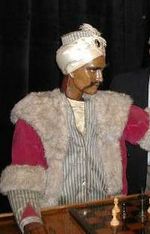
جون گوگان، صانع الآلات الأمريكي للسحرة، الذي كان يعيش في لوس أنجلس، أنفق 120,000 دولار في بناء نسخته من ماكينة كمپلن على مدى خمس سنوات، بدءاً من 1984.[28] The machine uses the original chessboard, which was stored separately from the original Turk and was not destroyed in the fire. The first public display of Gaughan's Turk was in November 1989 at a history of magic conference. The machine is presented much as Kempelen presented the original, except that it is now controlled by a computer.[29]
كشف السر
الثقافة الشعبية
التقليد
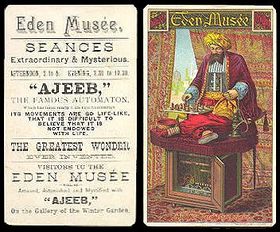
بسبب شعبية وغموض التركي الآلي ، فقد ألهم إنشاؤه العديد من الاختراعات والتقليدات،[3] بما فيهم عجيب، أو "المصري،" وهو تقليد أمريكي بناه تشارلز هپر لعب ضده الرئيس الأمريكي گروڤر كليڤلاند في 1885، ومفيستو، الماكينة التي وصفها أصحابها بأنها "أشهر" ماكينة في العالم، ولا يـُعرَف الكثير عنها.[30]
الماكينات الآلية
التركي زاره في لندن القس إدموند كارترايت في 1784. He was so intrigued by the Turk that he would later question whether "it is more difficult to construct a machine that shall weave than one which shall make all the variety of moves required in that complicated game." Cartwright would patent the prototype for a power loom within the year.[31] Sir Charles Wheatstone, an inventor, saw a later appearance of the Turk while it was owned by Mälzel. He also saw some of Mälzel's speaking machines, and Mälzel later presented a demonstration of speaking machines to a researcher and his teenage son. Alexander Graham Bell obtained a copy of a book by Kempelen on speaking machines after being inspired by seeing a similar machine built by Wheatstone; Bell went on to file the first successful patent for the telephone.[3]
نظائر الإنترنت
في 2005، أمازون دوت كوم أطلقت التركي الآلي لأمازون. The web-based software application coordinates programming tasks with human intelligence, inspired in part by the way Kempelen's Turk operated.[32] The program, still in beta, is designed to have humans perform tasks, such as color comparisons, that computers struggle with.[33]
الهامش
- ^ See SCHAFFER, Simon (1999), "Enlightened Automata", in CLARK et al. (Eds), The Sciences in Enlightened Europe, Chicago and London, The University of Chicago Press, pp. 126-165.
- ^ See, for instance, his An Attempt to Analyse the Automaton Chess Player, London, 1821
- ^ أ ب ت ث ج ح خ Ricky Jay, "The Automaton Chess Player, the Invisible Girl, and the Telephone," Jay's Journal of Anomalies, vol. 4 no. 4, 2000.
- ^ أ ب Edgar Allan Poe, "Maelzel's Chess-Player," Southern Literary Journal, April 1836; available on the internet via the Edgar Allan Poe Society of Baltimore, Maryland, URL accessed 19 December 2006.
- ^ أ ب Karl Gottlieb von Windisch, Briefe über den Schachspieler von Kempelen nebst drey Kupferstichen die diese berühmte Maschine vorstellen, or Inanimate Reason; or, A Circumstantial Account of that Astonishing Piece of Mechanism, M. de Kempelen's Chess-Player, Now Exhibiting at No. 9 Savile-Row, Burlington Gardens (London, 1784); translation taken from Levitt.
- ^ Stephen Patrick Rice, Minding the Machine: Languages of Class in Early Industrial America (Berkeley, University of California Press, 2004), 12.
- ^ Tom Standage, The Turk: The Life and Times of the Famous Eighteenth-Century Chess-Playing Machine (New York: Walker, 2002), 22–23.
- ^ The dimensions from Jay's Journal, which expresses them to the nearest half-foot. Metric versions thus can only be precise to the nearest multiple of fifteen centimetres. If we conventionally round to the closest multiple of five centimetres, the cabinet was very roughly 110×60×75 cm and the chessboard very roughly 50 cm square.
- ^ Standage, 24.
- ^ أ ب Standage, 88
- ^ Standage, 24–27.
- ^ Gerald M. Levitt, The Turk, Chess Automaton (Jefferson, N.C.: McFarland, 2000), 40.
- ^ Levitt, 147–150.
- ^ Sound: Standage, 27–9. Facial expressions: George Atkinson, Chess and Machine Intuition (Exeter: Intellect, 1998), 15–16.
- ^ Standage, 30–31.
- ^ Levitt, 38–39.
- ^ Levitt, 30.
- ^ ستاندگيت، 105–106.
- ^ Bradley Ewart, Chess: Man vs. Machine (London: Tantivy, 1980).
- ^ Levitt, 39–42.
- ^ ليفيت, 45.
- ^ ليفيت, 45–48.
- ^ ستاندجيت, 125.
- ^ Levitt, 92–93.
- ^ Levitt, 94–95.
- ^ Levitt, 97.
- ^ Silas Weir Mitchell, "The Last of a Veteran Chess Player," The Chess Monthly, January 1857; reprinted in Levitt's The Turk, Chess Automaton.
- ^ Levitt, 243.
- ^ Standage, 216–217.
- ^ Imitations: Jay, "The Automaton Chess Player, الفتاة غير المرئية، والهاتف. Ajeeb or the Egyptian: Ramón Jiménez, "The Rook Endgame Machine of Torres y Quevedo." ChessBase, 20 July 2004. URL accessed 15 January 2006. Played by Grover Cleveland: International Chess Magazine September 1885. Mephisto: Levitt, 154.
- ^ Levitt, 31–32.
- ^ Amazon.com: "FAQ: What is Amazon Mechanical Turk? URL accessed 15 January 2006.
- ^ Katharine Mieszkowski, "'I make $1.45 a week and I love it'," Salon.com, 24 July 2006. URL accessed 15 January 2007.
المصادر
- Atkinson, George. Chess and Machine Intuition. Exeter: Intellect, 1998; ISBN 1-871516-44-7.
- Ewart, Bradley. Chess: Man vs. Machine. London: Tantivy, 1980; ISBN 0-498-02167-X.
- Hankins, Thomas Leroy, and Robert J. Silverman. Instruments and the Imagination. Princeton, N.J.: Princeton University Press, 1995; ISBN 0-691-02997-0.
- Hsu, Feng-hsiung. Behind Deep Blue: Building the Computer that Defeated the World Chess Champion. Princeton, N.J.: Princeton University Press, 2002; ISBN 0-691-09065-3.
- Levitt, Gerald M. The Turk, Chess Automaton. Jefferson, N.C.: McFarland, 2000; ISBN 0-7864-0778-6.
- Löhr, Robert The Chess Machine. New York: Penguin Press, 2007; ISBN 1-59420-126-9.
- Rice, Stephen Patrick. Minding the Machine: Languages of Class in Early Industrial America. Berkeley: University of California Press, 2004; ISBN 0-520-22781-6.
- Standage, Tom. The Turk: The Life and Times of the Famous Eighteenth-Century Chess-Playing Machine. New York: Walker, 2002; ISBN 0-8027-1391-2.
- Wood, Gaby. Living Dolls: a Magical History of the Quest for Mechanical Life. London: Faber and Faber, 2002; ISBN 0-571-17879-0.
وصلات خارجية
| The Turk
]].- قالب:Chessgames player
- Clockwork Game:The illustrious career of a Chess-Playing Automation from clockwork-comics.com
